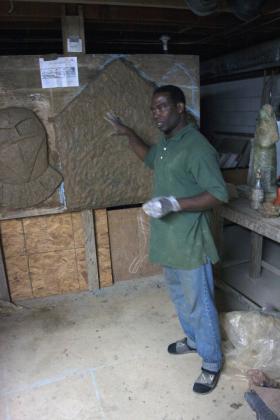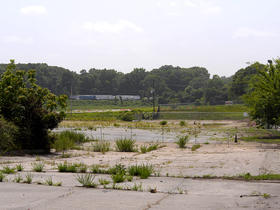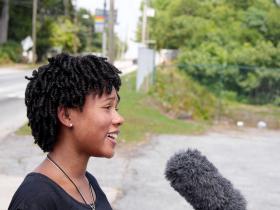Can Public Art Change a Community? University Avenue Project Bets ‘Yes.’

A celebration of the University Avenue Public Art Project takes place Saturday afternoon at 352 University Avenue in southwest Atlanta. The event will showcase the unveiling of three twenty-foot high-relief sculptures celebrating the past, present and future of southwest Atlanta’s neighborhoods.
The project has been in the works for over a year, and, as WABE’s Kate Sweeney reports, it’s about a whole lot more than simple beautification.
Broadcast version of story that aired Friday, July 11, 2014
352 University Avenue.
You may not be familiar with the exact address. It’s just down the road from Turner Field. Three miles from downtown. Five miles from Georgia Tech. And, with the Atlanta Beltline about to come in in along its back border, you might imagine this address a hot property.
But actually standing and looking at 352 University Avenue might lead you to a different opinion.
A sprawling 31-acre expanse of broken asphalt with weeds growing up through the cracks, the lot looks abandoned. And Diamond Wiggins—who has agreed to come and scope out the lot on a hot June day—can attest: It has looked this way, for years.
“Yes! I grew up over here. So, I’m twenty, turning twenty-one; and this has been this way, I want to say at least since eighteen years ago.”
Wiggins has only vague memories of the trucking companies that operated in this space until 2004. She lives in Pittsburgh, one of the four neighborhoods surrounding this property. The others are Adair Park, Capitol View, and Capitol View Manor.
“And it’s nice to see someone wanting to do something with it,” she continues. “We need it! Nobody wants to continue to drive past here and see this.”
Starting this weekend, people will see three twenty-foot cement sculptures here, created by artist Fred Ajanohga and a team of two assistants. Ajanohga’s art has been commissioned by organizations like the High Museum of Art and the Atlanta Olympic Games Committee.
His University Avenue sculptures will represent southwest Atlanta’s rich history and hoped-for future, including the bright promise of the Beltline.
The art project is a joint effort by WonderRoot, community members, and the Annie E. Casey Foundation, which owns the property. And the hope is that it will lead to more neighborhood investment—maybe even a mixed-use development here.
So, the three concrete sculptures? The idea is: They’re just the beginning.
33-year-old Adair Park resident Randy Gibbs describes his background in art pretty simply: “I’m not a big artist dude, right? I can appreciate arts, but that’s not my thing.”
Still, he recalls clearly how this art project appealed to him from the moment he heard about it. “My reaction was like, ‘Praise the lord. Something’s actually going to happen at that site.’”
That’s because the vast, vacant space at352 University has always felt like a wasteland to Gibbs, a void that infects people’s opinions of the surrounding neighborhoods.
It wasn’t always this way.
Southwest Atlanta once comprised a network of thriving communities. Pittsburgh in particular, held the distinction as being one of Atlanta’s oldest, most tightly-knit African-American neighborhoods.
But since the late 1960s, the area has been more often associated with poverty, drugs and crime than with historic legacy. With the 2008 recession, Pittsburgh was one of the hardest-hit neighborhoods in the nation. These days, many of its lots are populated by paint-peeling, abandoned houses.
Even so, Gibbs says that despite the public perception of this part of town, there’s beauty to be found here. He points to the architecture and the residents of southwest Atlanta, which he says inspired him to make two big moves. First, there was his move to Adair Park in 2011. Then, there was his decision to join the University Avenue Art Project’s Advisory Board.
“If this art project is simply an opportunity to display, you know, the art from our community artists, that’d be cool,” he says, “but that doesn’t meet the mark. It needs to do more than that; it needs to be a trigger for investment.”
But can an art project really bring economic growth to an area so long associated with blight?
Gregory Burbidge, Senior Program Specialist at the Atlanta Regional Commission’s Center for Livable Communities, says that’s tough to measure clearly. Many successful public art projects measure their success through purely anecdotal evidence.
In neighborhoods with public art, he says, “[t]hey find that people have a more positive image of their own neighborhood, they find their own neighborhood more walkable, and they find their neighborhoods safer.”
In short, he says, in places with public art, people tend to have positive experiences of their own communities. That’s the hope for University Avenue: that this art will begin to change the way people think of these neighborhoods.
And this kind of re-imagining isn’t without precedent in Atlanta.
Back in 2010, an annual public art extravaganza called Flux Night got its start in the neighborhood of Castleberry Hill. That event has been widely credited with improving both the economic climate and public image there.
Or, take the twelve art installations placed by Dashboard Co-op in vacant properties around town starting the same year. Eleven of those properties now house businesses.
Randy Gibbs says he’s confident that art can spark the same kind of change in Southwest Atlanta—although he doesn’t expect it overnight.
“You know, we’re not looking for someone to come in on a white horse and serve as a savior. No. But what we are looking for is, I guess, maybe a reason that we could leverage and build some momentum toward new development. So I definitely believe that this artwork–or any artwork done with the convictions of the communities, can have such an impact.”
As for Diamond Wiggins, the twenty-year-old who agreed to meet up to actually look at the vacant site, she believes in the project, too. In fact, she’s actually the youngest member of the art project’s advisory board.
What would she like to see at 352 University Avenue?
“On the property?” She laughs. “I actually have not thought about that one! I really haven’t…You get so used to things that it’s hard to picture what it would be. It would be nice to see what they come up with.”
Imagining things differently from what they are may be the principle challenge this project is posing to all Atlantans.
9(MDAxODM0MDY4MDEyMTY4NDA3MzI3YjkzMw004))





